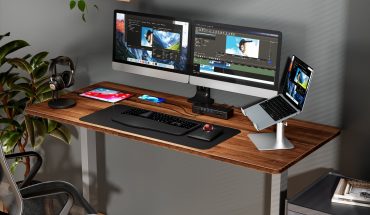Art is good for you. Good for your head, good for your heart.
It’s been shown that just looking at art has positive overall effects for mental and physical health at all stages of life. There’s on-going research that clearly shows art galleries, museums, and other cultural institutions contribute to public health and well-being.
And not a few high-tech art projects, too: one of the latest is at the Art Gallery of Ontario.
The Art Rate Monitor is a new technology-enabled experience that looks at your heartbeat while you look at art.
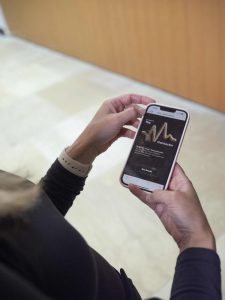
AGO visitors can wear a lightweight wristband, which like a fitness tracker, keeps track of their heart rate as they view art. Photo: AGO.
Gallery visitors wear a lightweight wristband which, like a fitness tracker, keeps track of their heart rate. A small relay and location device, worn as a lanyard, keeps track of your position by communicating with some 40 beacons installed throughout the Gallery (not the fifth floor, however).
Heart rate and location data are gathered and processed by the system, which was developed and installed by Toronto-based interactive technology studio WXM with international agency Zulu Alpha Kilo.
When you’re done, a personalized report is emailed out with data describing your heartfelt reactions: Which artwork sent your heart racing? Which one captivated you the longest? What colour palette most affected you? You can review the artworks that got your heart pumping and you can share them online with friends and family.
The Monitor is free with admission to the AGO and will be available to November 12.
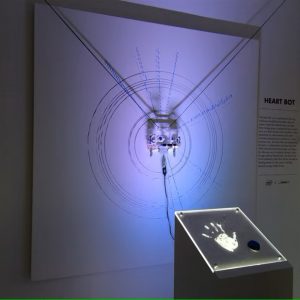
Intel Heart Bot, an experimental drawing machine powered by the heart rate of each viewer, at New Museum. Commissioned by Sid Lee for Intel x SMS audio collaboration. Produced with Tool of North America and Odd Division.
There’s Art Rate, and then there’s Heart Bot. One shows how art affects the heart, the other shows how the heart affects art.
Heart Bot generates artwork in real-time using the collected heartbeats of many visitors, input via a fixed pulse monitor mounted in a podium.
The pulse information is processed via software into commands for a robotic drawing arm, telling it how and where to move. Sharpie markers are affixed to the robotic arm, and it begins drawing from the middle of a concentric design, outwards. It’s more controlled than a series of random squiggles, and the clock-like result references the temporal nature of the human heartbeat.
Maybe its fragility, too: Heart Bot was featured for one day only at The New Museum in New York City; it occasionally makes appearances at consumer electronics shows.
And there’s Pulse Room, an interactive art installation featuring as many as 300 incandescent light bulbs, 300 watts each, suspended by cable at a height of three metres throughout the exhibit space.
A sensing device mounted in the room detects the heart rate of a participant when they holds it. His or her pulse immediately sets off the closest bulb to flash at the same rhythm as his or her heart. When the sensor is released, the lights go off.
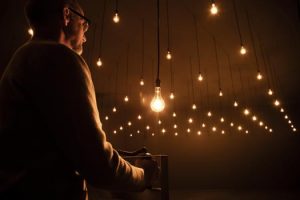
Rafael Lozano-Hemmer, Pulse Room, 2006. Shown at Latidos, Arte Abierto, Mexico City, Mexico, 2020. Photo by Mariana Yañez.
But the interaction is recorded, and each new participant pushes ahead all other sequences for continued playback across the array of lights.
These gallery and museum exhibits show the fascinating relationships among art, technology, and the human condition.
Our heartbeat and our brain waves, our emotions and our intellect, can all be used to react to and to create art.
As we’ve previously reported, computer visualizations of viewers’ brainwaves as they look at different paintings and objects in an art gallery are themselves a kind of art, and that’s being shown in yet another art exhibit that mashes up technology, human biology and creativity to make the point.
# # #
Making my way through the AGO, with Art Rate monitoring gadgetry on my wrist and around my neck, I nevertheless try to be my own data-gathering mechanism, making mental and emotional note of which artworks are attracting my eye, captivating my mind, holding my attention. I am mesmerized by Kazua Nakamura, and his Blue Dimension exhibit. I laugh out loud while looking at Defaced!, an exhibition of reworked currency, coins and money over the years. There’s a room full of Rembrandts, a floor full of Modernism. Each gets my heart going for different reasons. Each is recorded in my memory in different ways.
But inside Feeling Her Way, a brand-new exhibit by Sonia Boyce that just opened on the main floor of the AGO, I know my heart rate is way up!
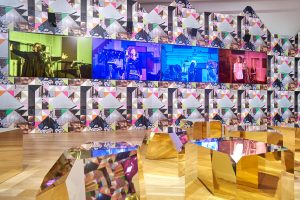
Now showing at the AGO: Large OLED screens are central to the presentation of a new exhibit. Sonia Boyce, Feeling Her Way, 2022.
Commissioned by the British Council for the
British Pavilion for the 59th International Art
Exhibition – La Biennale di Venezia
2022. © Sonia Boyce (Copyright Visual
ArtsCARCC, 2024). Installation view, Leeds Art
Gallery, 2023. Photo: Rob Battersby.
This immersive multimedia installation features the vocal performances of several Black women, recorded and displayed on top-of-the-line video monitors. There are four 83″and six 77″ LG OLED 4K G4 Smart TVs used in the exhibit, and each one has been tweaked at the pixel level to deliver colour-tinted imagery that evokes and responds to the vocalist being shown. LG’s newest OLED evo TVs feature AI upscaling for precise pixel-level image analysis and control, and it clearly shows on these screens. The exhibit is almost overwhelming with its rich visuals and complicated soundtrack, but time spent in the space is rewarding.
Now, the Art Rate Monitor did not capture (or at least, did not mention in its summary) my excitement in the Boyce exhibit. Nor unfortunately does the app capture heartbeats on the AGO’s fifth floor (where more music, videos, big screens and immersive installations are on display).
Too bad.
The fifth floor features a dynamic exhibit by contemporary artist Theaster Gates, which debuted at the AGO several years ago, and is now back at least in part. Called How to Build a House Museum, it features a large, dedicated room, or Progress Palace, that pays tribute to the legendary Chicago DJ Frankie Knuckles.
Here, you’re no longer in an art gallery; you’re in a dance club!
No way you can stand still in this space. The pulsating music and the larger-than-life visuals are too commanding. Guaranteed – your heart rate goes way up.
And you’ll feel really good as a result.
# # #

The Art Rate Monitor tracks your heart rate, and offers some personalized insights into your art gallery experience.
-30-
Here are more WhatsYourTech.ca stories about art and technology:
Technology Illuminates Much More than Ten Years of the Aga Khan Museum
The Aga Khan Museum in Toronto is celebrating ten years of operation with new art exhibitions and digital experiences it hopes will engage even wider audiences across a global stage.
Rumi Exhibition Spans the Centuries
Interactive display technology, digital 3D printing, and the ever-present influence of social media are integrated into a new museum exhibition exploring the life and work of a 13th century poet, Islamic scholar and Sufi mystic.
Art and Technology and the Future are on Display
Tick tock. We’re here. This is the future.
It’s launching this weekend as part of Nuit Blanche, the annual celebration of contemporary art: the final stop on a new augmented reality virtual tour of public art installations in downtown Toronto.



